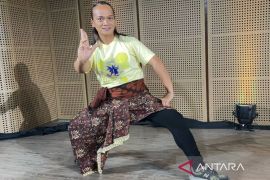Still, the 12-year-old managed to perform confidently and grab the audience's attention some time ago, receiving praises from several comedy icons, including Harry De Fretes and Indro from the legendary comedy group Warkop.
The 7th grader from East Jakarta's 99 Public Junior High School was determined to pursue acting. While his peers usually like K-pop or J-pop, he prefers lenong.
Kautsar is not alone; he and his friends at Ananda Arts Center are intent on preserving Betawi's culture through lenong.
Kautsar is one of the new faces in a growing group of young people who wish to preserve traditional arts amid the global pop culture wave.
Indeed, the emergence of modern lenong is an interesting phenomenon in Indonesian performing arts.
It can be seen as evidence that traditional arts do not have to be rigid and outdated. With a touch of innovation, lenong, which is known for its humorous stories, can remain relevant to the younger generation.
Young people like Kautsar, for example, have shown that regeneration in traditional arts is highly possible as long as there are opportunities for young people to develop.
While newcomers commonly get small roles, Kautsar managed to land the main role, under the guidance of Aditya Gumay, film director and owner of Ananda Arts Center.
This was not a decision made carelessly. His talent and passion were considered sufficiently developed to take modern lenong to a new level.
The Simpanan Juragan performance at Taman Ismail Marzuki in November 2024 was the first stage where young talents got to play the main role. It was a chance for them to prove themselves.
Senior actor Fretes stressed that the talents of young people must be appreciated.
Meanwhile, senior comedian Indro said that young talents must be given opportunities so that they can hone their skills and explore their potential.
For young talents, recognition from big names or seniors is an extraordinary motivation to move forward.
The story of Kautsar and the other young actors is not just about the development of individual talent. Rather, it illustrates how traditional arts such as lenong can be embraced by the younger generation.
While today's entertainment world is dominated by social media, blockbuster films, and global trends, modern lenong serves as a reminder that local arts can still adapt without losing their identity.
This is why cross-generational collaboration, as showcased in the Simpanan Juragan performance, is important. With senior actors and performers willing to share the stage with young people, the art of lenong could not only stay alive but also flourish.
Modern lenong is not merely about packaging lenong in a new style: it is about building a bridge between tradition and innovation, which is needed to attract younger generations.
By featuring stories that are relevant to current issues, inserting dialogues that are familiar to Generation Z, and utilizing technological elements, such as more modern lighting and music, lenong can become a fresh creative space.
Young people would no longer see it as "outdated," but as a space to express themselves and, at the same time, preserve culture.
Modern lenong performances also have a strategic role in building cultural identity. Amid globalization, people often forget about the rich local culture that can serve as a source of strength.
Young people like Kautsar are not only artists but also guardians of identity who can take Betawi stories to a wider audience.
This is essential amid the wave of foreign cultures that is continuing to dominate the domestic entertainment world.
This regeneration needs to be seriously supported, both by the government and art communities. One of the steps that can be taken is to provide more platforms for modern lenong.
Arts festivals, performances in schools, and the integration of lenong into the extracurricular curriculum could be some ways to introduce this performing art to more young people.
Apart from that, social media can also be utilized to promote lenong in a more simplified form, such as through short videos.
Efforts to ensure the continuity of modern lenong would require mentors like Gumay, who can diligently train and guide the younger generation.
Kautsar and his friends are proof that with the right support, young people can develop their talent in traditional arts.
Furthermore, appreciation from the public and the media is also essential. Appreciation from senior figures such as Fretes and Warkop shows that modern lenong can enjoy a strategic position in the entertainment world if it continues to be promoted seriously.
As a generation that was born in the digital era, young people can lend a unique touch to lenong performances by not only bringing their acting skills to the table but also new perspectives on the art.
By combining modern perspective and traditional values, lenong could be an effective tool to tell new stories that are relevant to the modern community.
Moreover, lenong has comedic elements that can appeal to diverse age groups.
The journey of Kautsar and his generation has not ended. Their preparations for the Lenong Bocah Reborn in February 2025 will be an important momentum to show that they are capable of emerging as the new generation of modern lenong actors.
Their story is a reflection of the big potential of traditional arts, if provided with opportunities to adapt and develop.
Through modern lenong, Indonesia can preserve its culture and also showcase the competitiveness of local arts in an increasingly competitive entertainment world.
The spirit of the youth can help lenong to live on and find a new home in the hearts of new generations, fueling hopes that the future of the traditional art is secured.
Translator: Hanni Sofia, Raka Adji
Editor: Aditya Eko Sigit Wicaksono
Copyright © ANTARA 2025












